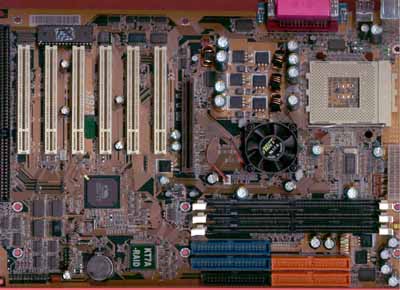VIA KT133A Motherboard Roundup - June 2001
by Mike Andrawes on June 13, 2001 2:52 PM EST- Posted in
- Motherboards
ABIT KT7A-RAID
|
ABIT KT7A-RAID |
|
|
CPU
Interface
|
Socket-A
|
|
Chipset
|
VIA KT133A Highpoint HPT370 IDE RAID (optional) |
|
Form
Factor
|
ATX
|
|
Bus
Speeds
|
100 - 183MHz (1MHz increments) |
|
Core
Voltages Supported
|
1.100 - 1.850V (0.025V increments) |
|
I/O
Voltages Supported
|
3.2
- 3.9V (0.1V increments)
|
|
Memory
Slots
|
3
168-pin DIMM slots
|
|
Expansion
Slots
|
1
AGP Slot |
|
On-board
Audio
|
N/A
|
|
BIOS
|
Award Modular BIOS 6.00PG |
The KT133 based KT7-RAID won our Editor's Choice Award back in July 2000 for
its brilliant design, performance, and stability. The new KT7A-RAID is based
on the same design and delivers on the high expectations placed on the follow
up to such a high quality product.
ABIT has never geared their products towards the OEM market; rather they have
designed their products for all the hardware enthusiasts out there with a strong
focus on overclocking features, which is exactly how ABIT has made their name.
Probably the most attractive feature of the board is SoftMenu III, which ABIT
has been using since the BX133-RAID. With SoftMenu, you can perform every overclocking
option right inside the BIOS, so you don't have to go through the hassle of
shutting down the machine and setting jumpers or dipswitches. While ABIT was
the pioneer of jumperless CPU setups with the original SoftMenu, they are no
longer the only game out there. Fortunately for ABIT, SoftMenu III continues
to be one of the best, easiest to use, and most flexible jumperless utility
out there.

The famous SoftMenu III setup
Provided that your chip is unlocked (either from the factory or by reconnecting the L1 bridges), you can easily change the CPU's clock multiplier right inside the BIOS, where you can also select any FSB speed between 100MHz and 183MHz in 1MHz increments. ABIT pioneered the idea of FSB speeds in 1MHz increments with the original SoftMenu III and has now become a hallmark of the feature. Inside the BIOS, you can also tweak the CPU core voltage as well as I/O voltage for added stability when overclocking.
Stability of the board has been very good as well. Although it is not the most stable KT133A we have tested, it only crashed twice in 24 hours, wihch is still very impressive among the boards we have here.
The layout of the board is virtually identical to the one on the KT7-RAID, with the biggest difference being that ABIT decided to put a full HSF unit on the 8363A North Bridge. This seems to be a good idea since the 8363A seems to generate considerable amounts of heat during normal operation, much less overclocked situations. The power connector is also very nicely placed so that power cables will not run over the CPU and memory. Unfortunately the otherwise excellent layout is marred by the placement of the CPU socket too close to the right edge of the board, making CPU removal difficult once everything is installed in a case.
The expansion slot configuration is one of the best we have seen. With six PCI slots, you should have plenty of room for all your expansion cards. The extra ISA slot will be welcomed by those who are still hanging onto those old legacy devices. You may have noticed that ABIT almost never includes AMR/CNR/ACR slots on their boards, mainly because of their target market where these cards are almost never used.
Last but not least, ABIT has also included the Highpoint HPT370 Ultra ATA 100 IDE RAID controller. It supports RAID 0, RAID 1, and RAID 0+1, the three most commonly used RAID setups out there. In fact, the KT7A-RAID is actually one of the only two boards that support these three modes. RAID 5 is excluded, of course, because it would require much more processing power than can be provided by a single chip solution like this. Of course, if you don't need or want RAID functionality, you can choose to use it as just a second IDE controller, for a total of four IDE channels on the board, supporting up to eight IDE devices. If you don't even want to use it as a secondary IDE controller, ABIT offers a non-RAID version of this board, known as the KT7A, that is otherwise identical.
Overall, the KT7A-RAID is a very nice KT133A motherboard. Although it doesn't stand out quite as much as its predecessor, mainly because the other manufacturers have caught up, ABIT set the standard for the KT133A market we see today. Of course, the overclocking options are truly phenomenal, as we've come to expect from ABIT.











0 Comments
View All Comments